WASHINGTON | The seventeen Linnaeus apostles, young, curious, and
adventurous, fanned out across the globe in the period 1745-1799. And
now their collected writings are traveling back – to 117 countries so far –
as a vital part of Swedish public diplomacy.
On a hot day in June 2015 a small trolley had to be used to bring the
eleven books of “The Linnaeus Apostles Global Science & Adventure”
in to one of the most spectacular offices in the American Capital.
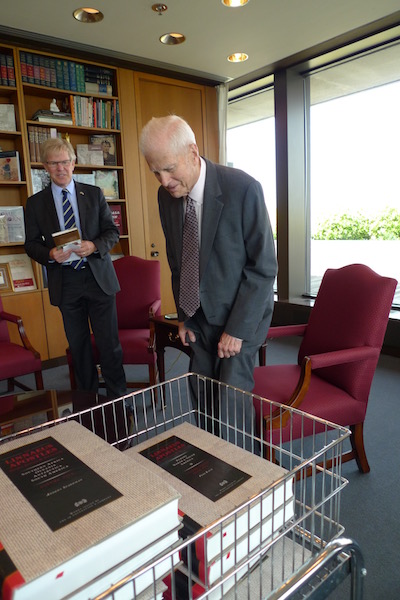
The heavy set of books – circa 30 kilos – is rolled in to the office of Librarian of Congress in Washington. Photograph: Karin Henriksson.
The office, which belongs to the Librarian of Congress, has stunning
views of the Washington monuments and museums. Present at the
ceremony was the soon-to-be-departing, long-time Librarian of
Congress, James H. Billington; his deputy David S. Mao who later
became the Acting Librarian of Congress; and the Swedish Ambassador
to the United States Björn Lyrvall, who handed over this gift to the
American people.
“Thomas Jefferson would have been pleased with this addition to the
Library’s collections not only because he was a serious bibliophile, but
also because the Kingdom of Sweden was the first non-combatant
country to recognize the independent United States in 1783 after the
American Revolutionary War”, David S. Mao said.
Mao pointed out that Jefferson actually sold his own collection of 6,487
books to the Library to replace the library’s original collection that was
burned during the war of 1812. Jefferson owned several works by Carl
Linnaeus and over the years the Library of Congress has acquired
hundreds of books by and about the Swedish naturalist as well as his
students, the “apostles” or “the disciples”.
And to this, Mao added:
“
The extensive collection of materials in this donation comprising all of
the Linnaeus apostles offers new and invaluable information to Library
patrons researching the history of science or looking into the current
branches of the natural sciences. Scholars from countries studied by the
apostles should find the information particularly illuminating.
”
Many Swedish diplomats, have in fact, been able to hand over the
Apostles’ series to libraries, scientific institutions, museums, botanical
gardens and other institutions in countries where Sweden is represented
by embassies and consulates. Some of the diplomats became so smitten
with the apostles and their adventures that they literally traveled in their
footsteps – a few times to try to find their graves.
There were many reasons for launching the massive project to transcribe
and translate the apostles’ journals, including that the seventeen young
men who departed Sweden hadn’t got the recognition they deserved,
according to former Swedish Prime Minister Ingvar Carlsson who acted
as one of the IK Foundation ambassadors from start.
“I learned about Carl Linnaeus in school, came across his name in
various settings, read a couple of his books about his travels to various
parts of Sweden, like Gotland and Västergötland, and I did know that he
had sent people out into the world, but not that much more”, said
Carlsson.
The motivating factor for Carlsson to get involved was the conviction
that Swedes in general have not been very good at promoting their many
pioneering scientists. With the Linnaeus apostles, he noted, it wasn’t just
a search for knowledge, it was also adventure and great danger in very
far away and unknown places.
“I was also impressed by Linnaeus’ logistical skills. He had traveled in
and around Sweden, but there he was in the middle of the 18th century
also planning travels across the globe”, stated Carlsson in awe.
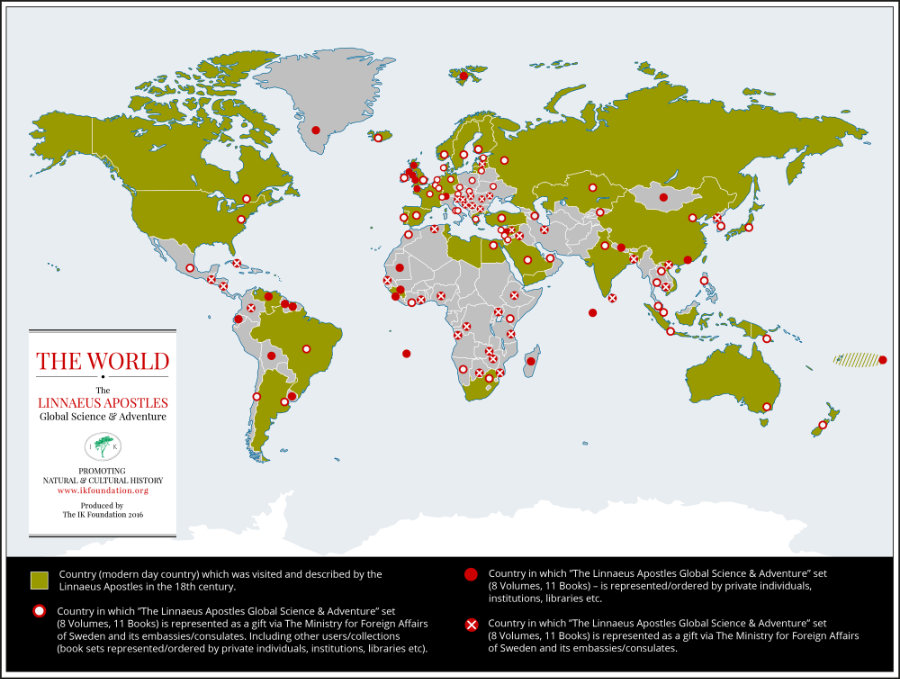
THE WORLD MAP | The book series The Linnaeus Apostles Global Science & Adventure (8 volumes/11 books) – covering more than 6000 pages – has since its publication in the years 2007-2012 been appreciated as the definite work of these seventeen naturalists' journals. Their missions stretched all continents during the period 1745 to 1799. This map gives a detailed view of the widespread geographical interest for the books, which today is represented in libraries, academic institutions, museums and private homes in 117 countries. The set of books have been published/sold by The IK Foundation or represented as a gift via The Ministry for Foreign Affairs of Sweden and its embassies/consulates among other networks.
Occasionally, the funding was tight. “Not an easy task”, according to an
understatement from Carlsson. However, in the end it was possible to
convince corporations, science academies, various foundations and
others to contribute. Carlsson stressed that the most gratifying thing for
him is to imagine all the libraries in the world where the “The Linnaeus
Apostles Global Science & Adventure” can be read and studied, not to
say enjoyed, considering the sometimes lively descriptions the apostles
used to document their experiences.
One of the libraries in possession of the full set of books is in Astana,
the capital of Kazakhstan, a former Soviet Republic. They were handed
over in 2013 to the National Library, which is quite different from the
American Library of Congress in size and scope.
“A project like this can be very valuable for a country without
substantial written records. A quarter of a century after independence
Kazakhstan finds itself in a process where a sound writing of history has
only just begun,” said Christian Kamill, the Swedish ambassador.
There have only been a few cultural exchanges between Sweden and the
vast country that is now Kazakhstan. The apostle
Johan Peter Falck was
the first known visitor; a century later the Swedish composer Wilhelm
Harteveld arrived to document songs sung by prisoners and other people
that had been expelled to Siberia; and then the two Nobel brothers
Robert and Ludvig, arrived in Atyrau at the Caspian Sea to extract oil
(later with the more famous brother Alfred as a co-financier). Certainly
three interesting cases, stressed Ambassador Kamill, but mainly an attest
as to how scarce the contacts were.
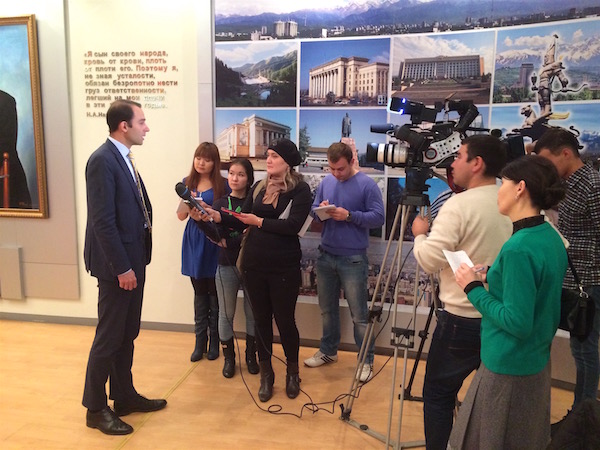
Christian Kamill, the Swedish ambassador in Kazakhstan, was visited by interested journalist, when the “Bridge Builder Expeditions” was presented by the IK Foundation on the regional museum in Petropavlovsk in northern Kazakhstan. Photograph: Lars Hansen.
Johan Peter Falck was the apostle that traveled the farthest on land. He
reached the northernmost and northwestern parts of Kazakhstan, but he
also documented findings from other regions, not the least of which
were the network of caravan routes. That was the reason for a joint
decision by the Swedish Embassy and the IK Foundation to venture outside
the capital to the areas where Falck and part of his expedition went. The
welcoming reception by the people in the city of Petropavlovsk in
northern Kazakhstan was very cordial during the visit in 2015, according
to Ambassador Kamill. The regional museum had arranged a symposium
about Falck and the publication of the works by the Linnaeus apostles.
An exhibit that showcased Falck’s travels is now a permanent fixture in
the museum. Ambassador Kamill pointed out that the Kazakh media are
very interested in foreign visitors, and newspapers, radio and television
covered this event that added valuable knowledge about the once
nomadic country’s history. The IK Foundation is planning similar future
trips as part of its ongoing project
Bridge Builder Expeditions – Russia
& Kazakhstan.
Svetlana Kovalskaja, a history professor at the Eurasian National
University, said that the names of Linnaeus and Falck are well-known in
the academic community and she mentioned the 1966 edition of the
"Essay on the history of ethnographic study of the Kazakh people in the
USSR” where the Kazakh scientist/ethnographer Edige Massanov
devoted an entire section to the ethnographic works of the second
academic expedition in the 18th Century, in which Falck and many others
participated.
“We know that Falck, unlike other members of the expedition, paid
special attention to ethnographic data about Kazakhs”, said Svetlana
Kovalskaja, noting that Falck’s work is still used in Kazakh history
studies. She continued that Falck “described the pastoral economy,
hunting, Kazakh folk crafts, food. He recorded many Kazakh terms and
words. He also made a comparative glossary of the Kazan Tatars,
Kazakhs, Kalmyks and other peoples”.
Johan Peter Falck died in Kazan, Russia, on March 31, 1774, after six
years of in the field.
Even during Linnaeus’ lifetime, cities like Paris and Rome were
important travel destinations (for the very few that did travel). As we
know, Linnaeus and his apostles, though, had set their sights on more
distant lands. But of course the French and Italian academic institutions
played significant roles in the world of research then, as they do now.
Christine Hammarstrand, of the department for press and information at
the Swedish Embassy in Paris, explained that Collège de France seemed
to be the most proper recipient in France.
“There are 14 Linnaeus societies in France. And it’s worth noting that
Carl Linnaeus had a great rival here, the naturalist George-Louis Leclerc,
Comte de Buffon. But Linnaeus himself had a very famous ally in Jean-
Jacques Rousseau and he sided with the Swede. And the Linnaeus -
Buffon dispute is still fought 300 years later,” added Hammarstrand,
also pointing out that the events in connection with the handing over of
the apostles’ volumes in 2014 certainly have expanded the international
science exchange.
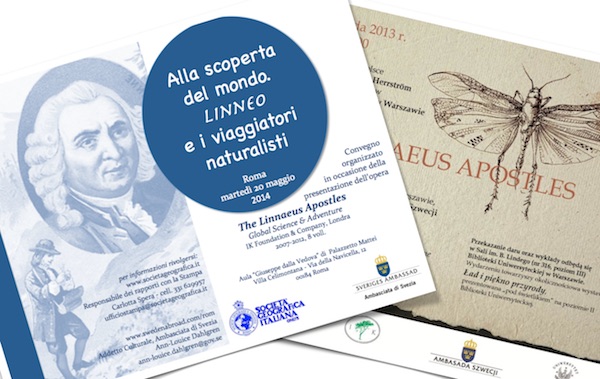
Examples of programs and invitation cards from various arrangements – when presenting a donation of the monumental reference books.
In Rome, at about the same time, the Swedish Embassy organized a
seminar together with the Società Geografica Italiana at Palazzo Matteri
in Villa Celimontana. Ambassador Ruth Jacoby and the president of the
society, Sergio Conti, opened the seminar, which took the audience on a
journey to many continents. Several professors presented lectures
dealing with subjects ranging from how the apostles developed Linnaeus’
theories to stories about famous Italian explorers - Orazio Antinori,
Giacomo Bove, Umberto Cagni, Pellegrino Matteucci. The Linnaeus
Apostles’ are now housed in the library at the Società Geografica
Italiana. And, in Italian, you don’t say Carl Linnaeus, Carolus Linnaeus
or Carl von Linné but Carlo Linneo.
There is ample documentation of ceremonies where Swedish diplomats
pose with recipients of the “The Linnaeus Apostles Global Science &
Adventure”. For instance in 2013 a set was donated to the Library at the
Australian National University, ANU, with the following comment from
the Librarian Roxanne Missingham: “The ANU Library is excited to
stimulate new thinking and research, and provide exciting reading about
cultures, landscapes, and people of a bygone era.” The university
representatives mentioned that Linnaeus’ research, and his role as the
father of modern taxonomy were recognized by the university in 2011
when the new Research School of Biology building was named the
Linnaeus Building.
In several cases the books were welcome additions to collections that
already contained works by Linnaeus himself or the apostles, for
example the Teylers Museum in Haarlem in the Netherlands.
And, sometimes the recipients could tell anecdotes like the one about
Fredrik Hasselquist. He never intended to visit Cyprus, but had to
change ships in Larnaca in 1751, stayed for a few weeks, and made
several observations about the views, vipers, wine, trade etc.
Hasselquist’s diaries from his travels in the Levant “opened new paths of
knowledge to Europe about the nature and cultures of the Orient” said
Professor Constantinos Christophides at the ceremony where he stated
that it is a ”privilege to havet hese volumes made available to the
University of Cyprus.
At the Foreign Ministry in Stockholm Håkan Hjort is the head of the
department called Cultural Promotion and the Image of Sweden. He
said, unequivocally, that the legacy of Carl Linnaeus is vital, not only in
terms of tourism and the image of Sweden, but also in helping to
increase the interest in the natural sciences among students. In
connection with the 300th anniversary of Linnaeus’ birth in 2007, many
Swedish embassies organized separate exhibits and various programs
looking back at his life and his importance in various fields.
In Washington, DC, as well as throughout the eastern United States and
eastern Canada, the travels of the apostle
Pehr Kalm generate the most
interest. He arrived in Wilmington in what today is the state of Delaware
mid-September 1748. He writes most charmingly about his reaction to
everything he encountered, “a new world” as he put it until panic set in
when he realized the enormity of the task ahead of him.
Kalm struck up close friendships with several highly educated and
influential men in the great city of Philadelphia, including Benjamin
Franklin and the botanist John Bartram, whose home and 45-acre garden
on the Schuylkill River is now a National Historic Landmark. The
curator, Dr. Joel Fry, stressed that Kalm’s observations have been
crucial for the overall knowledge of the region at the time, including
such diverse data as temperatures and Indian traditions.
“His friends were quite upset after he left and asked each other, ’Have
you heard from that scoundrel Kalm?’ But they never did,” said Joel
Fry, noting that it could take several months, or even years, for a letter
from Europe to reach the British colonies in North America. Some were
even lost. Kalm is one of the more “famous” apostles, and his own
books about the trip to North America have been available since
publication 1753-61. A second
Bridge Builder Expedition in Kalm’s
footsteps is also ongoing, with the intent to better understand how the
apostles’ work came to be part of the overall scientific knowledge – then
and now.
There is one more as-of-yet unfulfilled dream among Linnaeus’
admirers: to preserve his legacy internationally as a Unesco World
Heritage Site. It would include twelve properties in eight countries on
five continents that all bear witness to Linnaeus’ development of
systematic biology, among them Bartram’s Garden. In order for this to
happen, the governments in the countries involved would have to
officially put forward the sites in their respective countries on a tentative
list of nominees at least a year in advance. Only Sweden has done this.
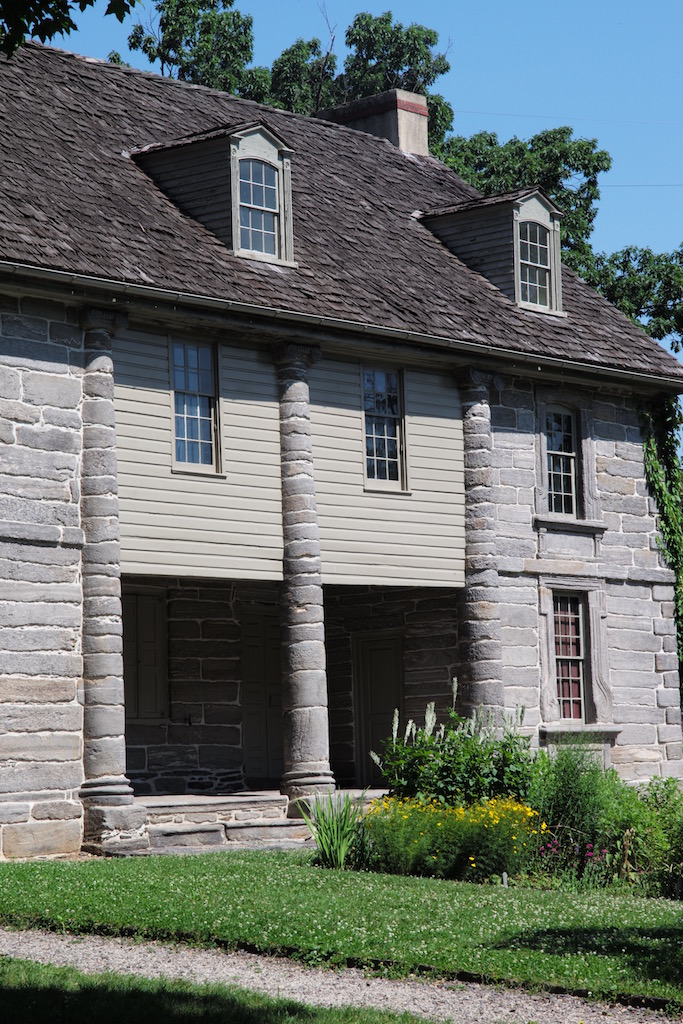
Bartram’s house was originally built between 1728-1731 and expanded at various stages up to 1770 – here illustrated with its building design and facade still well-preserved today. The reconstruction of the garden, which present-day visitors can study and enjoy, concentrates on native American plants, cultivated by several generations of the Bartram family from about 1728 to 1850. Photograph: Lars Hansen
“Our presumptive partners haven’t gotten quite that far. Therefore we
cannot hand in a nomination in 2016, and instead we will continue to
prepare for a nomination in, and outside, of Sweden”, said Dr. Anja
Rautenberg who is responsible for the "The Rise of Systematic Biology"
at the County Administrative Board in the Province of Uppsala.
This effort will certainly continue in Carl Linnaeus’ home town where
three of the sites are situated: his residence Hammarby; the surrounding
areas where he took students on walks to teach them how to observe
nature; Herbationes Upsaliensis, and the Linnaeus’ Garden. The fourth
site in Sweden is the birthplace of Carl Linnaeus in Råshult in the region
of Småland.
However the collection of 2000 items by Carl Linnaeus and the apostles
– filling up a 100 meter long shelf – at the Danish National Library of
Science and Medicine has been placed on Unesco’s Memory of the
World International Register. This unique collection was formed when
the books and papers owned by a private Danish book collector was
merged with the holdings of the National Library at the end of the
1980s. It was therefore a given that the library was deemed the best
home in Denmark for “The Linnaeus Apostles Global Science &
Adventure.”



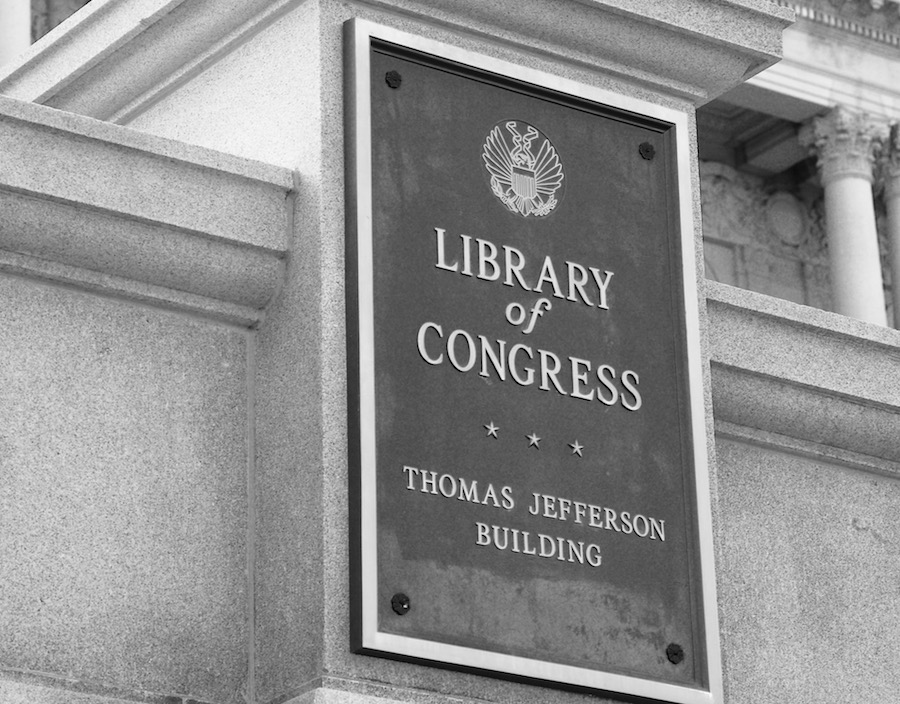
 The heavy set of books – circa 30 kilos – is rolled in to the office of Librarian of Congress in Washington. Photograph: Karin Henriksson.
The heavy set of books – circa 30 kilos – is rolled in to the office of Librarian of Congress in Washington. Photograph: Karin Henriksson.

 Christian Kamill, the Swedish ambassador in Kazakhstan, was visited by interested journalist, when the “Bridge Builder Expeditions” was presented by the IK Foundation on the regional museum in Petropavlovsk in northern Kazakhstan. Photograph: Lars Hansen.
Christian Kamill, the Swedish ambassador in Kazakhstan, was visited by interested journalist, when the “Bridge Builder Expeditions” was presented by the IK Foundation on the regional museum in Petropavlovsk in northern Kazakhstan. Photograph: Lars Hansen.  Examples of programs and invitation cards from various arrangements – when presenting a donation of the monumental reference books.
Examples of programs and invitation cards from various arrangements – when presenting a donation of the monumental reference books.





